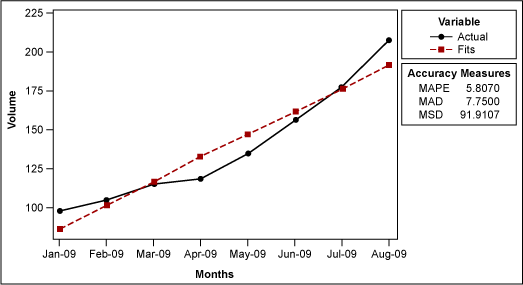Tag: analysis

Making Sense of Time Series Forecasting
Published:It is a common scenario: A practitioner has sales data for the past several months and wants to forecast next month’s sales volume. This type of forecasting can help manufacturers and distributors ensure they have enough product to meet customer demands. But how is this forecasting done? Statistical analysis software offers two ways to plot […]
Read more »
MoreSteam.com Receives Patent for EngineRoom Software
Published:Today the U.S. Patent and Trademark Office (USPTO) granted patent rights to MoreSteam.com for inventions developed by MoreSteam’s President, Bill Hathaway.
Read more »
Harnessing the Power of Predictive Analytics
Published:The demand for business intelligence continually increases. Tapping into predictive analytics, a type of data mining that can be used to make reliable predictions of future events based on analysis of historical data, can help.
Read more »
Pareto Principle (80/20 Rule)
Published:Vilfredo Pareto was an economist who is credited with establishing what is now widely known as the Pareto Principle or 80/20 rule. When he discovered the principle, it established that 80 percent of the land in Italy was owned by 20 percent of the population. Later, he discovered that the pareto principle was valid in other parts […]
Read more »
Rounding and Round-off Rules
Published:When performing statistical data analyses, quality professionals are always challenged to maintain data integrity. When should you round up the answer; when should you round down? How many significant figures are appropriate for the data set that has been taken? Below are a set of simple rules that should help you traverse the perils of […]
Read more »
Actionable Information from Soft Data
Published:Engineers, Six Sigma practitioners and other researchers often work with “hard” data – discrete data that can be counted and legitimately expressed as ratios. But what of “soft” data, things like opinions, attitudes and satisfaction? Can statistical process controls (SPC) be applied here? Can process variation in customer satisfaction, for example, be measured and then reported to […]
Read more »
Are You Sure Your Data Is Normal?
Published:Most processes, particularly those involving life data and reliability, are not normally distributed. Most Six Sigma and process capability tools, however, assume normality. Only through verifying data normality and selecting the appropriate data analysis method will the results be accurate. This article discusses the non-normality issue and helps the reader understand some options for analyzing […]
Read more »
Attribute Agreement Analysis for Defect Databases
Published:A defect database that tracks errors in processes (or even products) – a database that is so sophisticated that it actually tracks where the defect occurred in addition to the type of defect – can provide powerful information. It can be quite helpful in scoping and prioritizing potential improvement opportunities. But is the data trustworthy? […]
Read more »
Minimize the Risk of the Unknown in Six Sigma Projects
Published:“You don’t know what you don’t know.” That phrase has been taught in Black Belt training for many years, and it continues to be relevant today. When combined with a related phrase, “What you don’t know can hurt you,” these words illustrate a common challenge: Sometimes, the events that hurt us are unknown and unexpected. […]
Read more »
A Parallel Process View for Information Technology
Published:The value and impact that a solid Design for Six Sigma (DFSS) approach can bring to an IT business is well known. While many organizations understand the relationship between DFSS and their own project management approach, what they often miss is attention to the foundational concepts of Lean and DMAIC (Define, Measure, Analyze, Improve, Control) […]
Read more »
Discriminant Analysis Can Minimize Returned Products
Published:Accurate predictions, optimal decisions, and an explanation of root cause and its effects on a process are just a few of the many types of solutions managers are expected to deliver when complex problems appear. Yet, discriminant analysis, one of the most powerful tools used to solve problems in a process, is often neglected in […]
Read more »
Analytical Treatment of Discrete Ordered Category Data
Published:Ordered category data is discrete data representing appraiser or client perception against a rating scale such as a survey or questionnaire. Black Belts learning to apply the Six Sigma methodology to ordered category data are traditionally taught analytical methods that include normal and Poisson distributions. This is probably due to Six Sigma’s beginnings in manufacturing. […]
Read more »
Product Guide: Statistical Analysis Software
Published:This directory highlights the features, as well as format, language and price specifics, of several statistical analysis software programs.
Read more »
Connecting Six Sigma to CMMI Measurement and Analysis
Published:Measurement and analysis (MA) is a Level 2 support process area within the Capability Maturity Model Integration (CMMI) process. The purpose of MA is to provide management information necessary to implement monitoring and control of various required processes. Source: Ahern, Clouse and Turner, CMMI Distilled: A Practical Introduction to Integrated Process Improvement, second edition, Addison […]
Read more »
Simulation Modeling Best Addition to Analysis Toolkit
Published:Because of the rapid growth and increased competition in information technology (IT), business process outsourcing (BPO) and other service sector industries in India, quality and cost of operations have become the major distinguishing factors among such companies. Survival, growth and profits depend on how an organization controls its costs and satisfies its clients or customers. […]
Read more »
Implications of Analyses of Software Inspections Data
Published:A variety of analyses can be done during the Analyze phase of a Six Sigma DMAIC (Define, Measure, Analyze, Improve, Control) software project with data from Fagan-style inspections. These analyses suggest possible implications when considering Improve activities. Analyses used here are based on a real situation and the conclusions drawn are valid in that situation, […]
Read more »
Why You Cannot Depend Totally on Statistical Software
Published:The proliferation of do-it-yourself statistical software can give some Six Sigma practitioners, who may not be strong in statistics, a false sense of confidence. For the most accurate results, follow these eight tips before you begin collecting and analyzing data.
Read more »